|
April 1970 Popular Electronics
 Table
of Contents Table
of Contents
Wax nostalgic about and learn from the history of early electronics. See articles
from
Popular Electronics,
published October 1954 - April 1985. All copyrights are hereby acknowledged.
|
The unijunction transistor
(UJT), invented in 1953, was originally known as a "double-base diode" and explains
why to this day the terminals are labeled "E," "B1,' and B2." It is commonly modeled
as a diode connected between two resistors, with one resistor being variable. As
the name implies, unlike a bipolar junction transistor (BJT) that is more familiar
to most people and has two semiconductor junctions connected to the base, a UJT
has just one junction. As is explained in detail in this 1970 Popular Electronics
article, the net effect of the UJT's arrangement is a region of negative resistance
which makes it good for use as an oscillator. In fact, the relaxation oscillator
was one of the most popular uses of the UJT.
An all-round signal generator: saw-tooth, square-wave, sine-wave.
 By Frank H. Tooker By Frank H. Tooker
Almost everyone who has an interest in electronics is aware of the existence
of a device called the unijunction transistor, or UJT. (If he remembers it from
its very beginning, he might recall that it was originally referred to as a "double-base
diode.") The UJT is used most often in circuits requiring a positive-going spike
pulse and, occasionally, as a generator of sawtooth waveforms.
However, the UJT is actually much more versatile than these two uses would imply.
It can also be used to generate square waves and, believe it or not, sine waves
having quite pure waveforms. It behooves the serious electronics experimenter to
learn more about all of these uses - and to do so, he will need to know more about
the UJT itself.
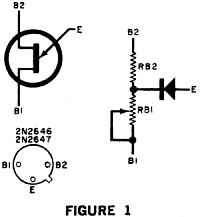 How the UJT works. The UJT can be represented
by a circuit approximation consisting of two resistances in series, with a diode
connected at their junction as in Fig. 1. (Also shown in the figure is the
accepted schematic symbol and base diagram for the UJT. Note that in both cases
the leads are identified as E, B1, and B2 for emitter, base-1, and base-2.) The
resistance approximation is a passive representation of the UJT. In simple terms,
this means that a pair of resistors and a diode connected as shown will not operate
as a unijunction transistor. The approximation is simply a means by which operation
of the UJT can be explained. How the UJT works. The UJT can be represented
by a circuit approximation consisting of two resistances in series, with a diode
connected at their junction as in Fig. 1. (Also shown in the figure is the
accepted schematic symbol and base diagram for the UJT. Note that in both cases
the leads are identified as E, B1, and B2 for emitter, base-1, and base-2.) The
resistance approximation is a passive representation of the UJT. In simple terms,
this means that a pair of resistors and a diode connected as shown will not operate
as a unijunction transistor. The approximation is simply a means by which operation
of the UJT can be explained.
In the majority of applications, the emitter is the control electrode of the
UJT. The magnitude and polarity of a potential applied to the emitter determine
whether or not the UJT will fire. With the emitter circuit open (diode nonconducting),
resistance RB1 is maximum, and the sum of RB1 and RB2) called interbase resistance,
is between 5000 and 10,000 ohms for the 2N2646 and 2N2647 (two typical, useful UJT's).
Resistance RB1 is shown variable because current flow in the emitter circuit
causes a decrease in the ohmic value of this resistance. The greater the current
flow, the lower the resistance. Hence, a UJT exhibits negative resistance, a characteristic
that can be thought of as amplification. What actually happens inside the UJT is
that current flowing into the E-to-B1 circuit "pulls" current carriers from the
B2 area, increasing the circuit's conductance.
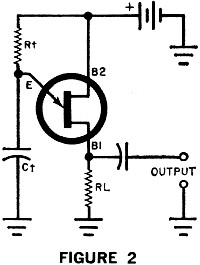 The supply voltage, usually applied through
a series resistor, is connected across the interbase resistance, B1 to B2, with
B2 positive with respect to B1. To fire the UJT, a positive potential (called the
peak-point voltage) is applied to the emitter. The supply voltage, usually applied through
a series resistor, is connected across the interbase resistance, B1 to B2, with
B2 positive with respect to B1. To fire the UJT, a positive potential (called the
peak-point voltage) is applied to the emitter.
The ratio of RB1 to the interbase resistance is called η (Greek eta), or the
intrinsic standoff ratio. The peak-point voltage is this ratio times the supply
voltage plus the potential hill of the diode (about 0.5 volt). Thus, the voltage
required for firing the UJT varies as the supply voltage is varied, and in the same
direction.
UJT relaxation oscillators. The schematic diagram in Fig. 2, or some variation
of it, is probably familiar to most experimenters. It is the one most commonly used
circuits for relaxation oscillators by circuit designers.
Referring to the diagram, capacitor Ct charges up through resistor Rt at a rate
determined by the RC time constant of these two components. The larger these values,
the slower the charging rate. During the charging interval, the emitter junction
is reverse biased, and the only current flowing in the emitter circuit is due to
leakage (similar to the Ico of a bipolar transistor). Emitter leakage
for the 2N2646 is a maximum of 2 µA, and for the 2N2647, only 0.2 µA.
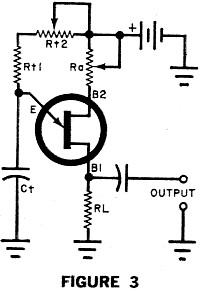 When the potential across Ct reaches the value
of peak-point voltage for the particular UJT being used in the circuit, the emitter
junction goes suddenly into conduction. Using the UJT approximation shown in Fig. 1,
RBl promptly drops to a much lower value and Ct in Fig. 2 discharges abruptly
through load resistor RL, producing a spike pulse of voltage across the output terminals. When the potential across Ct reaches the value
of peak-point voltage for the particular UJT being used in the circuit, the emitter
junction goes suddenly into conduction. Using the UJT approximation shown in Fig. 1,
RBl promptly drops to a much lower value and Ct in Fig. 2 discharges abruptly
through load resistor RL, producing a spike pulse of voltage across the output terminals.
Capacitor Ct does not discharge to zero potential. Rather, it is discharged to
a value determined by the series resistance between the emitter and ground and the
magnitude of the discharge current. The actual value to which Ct discharges is termed
the "valley voltage." When Ct discharges to this value, the emitter junction of
the UJT becomes reverse biased again; then Ct begins to recharge, and the cycle
repeats. The charge-discharge action of Ct produces a sawtooth waveform signal.
When it doesn't work. The operation of a UJT relaxation oscillator involves more
than just raising the potential across timing capacitor at to the firing level.
A certain value of current, called the "peak-point emitter current," is required
to fire the unijunction transistor. This current must be supplied through timing
resistor Rt (see Fig. 2). If the current through Rt is too low, capacitor Ct
will charge to a value that is below the peak-point voltage, and operation will
cease. The UJT will not fire. This need for sufficient emitter current becomes important
when Rt must have a large value to operate the UJT at a very low repetition rate.
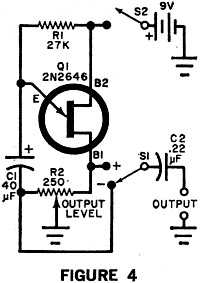 The peak-point emitter current for the 2N2646
is about 5 µA; for the 2N2647 it is only 2 µA. It is important to bear in mind that
even though the 2N2647 is 2.5 times better than the 2N2646, if an electrolytic capacitor
is used in the circuit, the leakage current of the capacitor has the same effect
as an identical increase in the peak-point emitter current of the UJT. Consequently,
care must be exercised in choosing a capacitor with the lowest leakage or the value
of the 2N2647 might be lost. The peak-point emitter current for the 2N2646
is about 5 µA; for the 2N2647 it is only 2 µA. It is important to bear in mind that
even though the 2N2647 is 2.5 times better than the 2N2646, if an electrolytic capacitor
is used in the circuit, the leakage current of the capacitor has the same effect
as an identical increase in the peak-point emitter current of the UJT. Consequently,
care must be exercised in choosing a capacitor with the lowest leakage or the value
of the 2N2647 might be lost.
Characteristics vary from one UJT to another, even for those with the same type
number. Thus, if the relaxation oscillator is to have a definite repetition rate,
the value of timing resistor Rt should be made adjustable to allow you to "trim"
the circuit to the desired frequency or repetition rate.
The circuit shown in Fig. 3 has trimming facilities. Varying the resistance
of either Ra or Rt2 varies the interbase voltage, thereby altering the peak-point
voltage and, thus, the repetition rate. The value of potentiometer Ra in such a
circuit should be limited to a maximum of 5000 ohms.
Negative-pulse generator. Pulses obtained at the B1 terminal of a UJT are positive-going.
Negative-going pulses can be obtained from the B2 terminal when a resistor is connected
between B2 and ground. Negative pulses can also be obtained from a resistor connected
in series with the lower end of the timing capacitor.
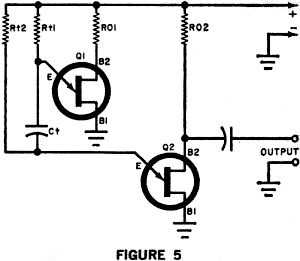 The circuit shown in Fig. 4 provides a
choice of either positive or negative pulses, depending on the setting of S1. Adjusting
the setting of level control potentiometer R2 adds resistance to one of the two
circuits, while it subtracts an equal amount of resistance from the other circuit.
So, when R2 is set for maximum amplitude of a negative output pulse, resistance
in the positive side of the circuit is zero, and vice versa. This gives the circuit
maximum efficiency, providing maximum pulse amplitude in either direction. The circuit shown in Fig. 4 provides a
choice of either positive or negative pulses, depending on the setting of S1. Adjusting
the setting of level control potentiometer R2 adds resistance to one of the two
circuits, while it subtracts an equal amount of resistance from the other circuit.
So, when R2 is set for maximum amplitude of a negative output pulse, resistance
in the positive side of the circuit is zero, and vice versa. This gives the circuit
maximum efficiency, providing maximum pulse amplitude in either direction.
The repetition rate of the circuit with the component values shown is about one
pulse in every two seconds. This rate was selected to provide a useful instrument
for checking experimental hookups of JK flip-flops, SCR's, SCS's, and other pulse-operated
devices.
Square-wave generator. The circuit of a square-wave generator (actually a dual-UJT
multivibrator) is shown in Fig. 5. This circuit generates excellent square
waves within the frequency range of efficient operation of the unijunction transistors.
When the power is applied to the dual-UJT circuit, both emitters are made positive
with respect to ground through resistors Rt1 and Rt2. One UJT fires promptly, bringing
both ends of the timing capacitor, Ct, to a value well below the peak-point voltage.
This UJT remains conducting while Ct charges through the timing resistor of the
other UJT circuit.
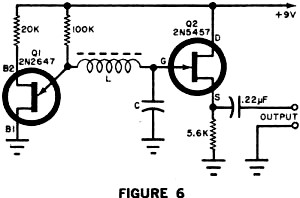 As soon as the second UJT's emitter becomes
sufficiently positive with respect to ground, it suddenly conducts, driving the
first UJT negative and causing it to stop conducting. With the second UJT conducting
and the first cut off, Ct starts charging in the opposite direction, through the
timing resistor of the first UJT. Now, when the emitter of the first UJT becomes
sufficiently positive, it fires, and the second UJT cuts off. The alternate- stage
fire/cutoff cycle is self repeating whenever power is applied to the circuit, and
the output of the system is a train of rectangular pulses. As soon as the second UJT's emitter becomes
sufficiently positive with respect to ground, it suddenly conducts, driving the
first UJT negative and causing it to stop conducting. With the second UJT conducting
and the first cut off, Ct starts charging in the opposite direction, through the
timing resistor of the first UJT. Now, when the emitter of the first UJT becomes
sufficiently positive, it fires, and the second UJT cuts off. The alternate- stage
fire/cutoff cycle is self repeating whenever power is applied to the circuit, and
the output of the system is a train of rectangular pulses.
Sine-wave generator. Sine waves are produced by allowing a UJT circuit to charge
and discharge a capacitor through an inductance. When the charge-discharge period
is equal to the resonant frequency of the LC circuit, sine waves are generated across
the capacitor. A schematic diagram of a UJT sine-wave generator is shown in Fig. 6.
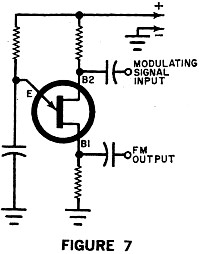 The tuned circuit of the generator is made up
of inductor L and capacitor C. Field effect transistor Q2 operates as a source follower
to prevent loading down the tuned circuit; this stage is not otherwise essential
to the operation of the oscillator as a sine-wave generator. The circuit shown has
operated well up to 50,000 Hz. The tuned circuit of the generator is made up
of inductor L and capacitor C. Field effect transistor Q2 operates as a source follower
to prevent loading down the tuned circuit; this stage is not otherwise essential
to the operation of the oscillator as a sine-wave generator. The circuit shown has
operated well up to 50,000 Hz.
The output of the sine-wave generator is obtained across Q1's source resistor.
The waveform here is cleanest when the ratio of inductance to capacitance is high.
Modulate a relaxation oscillator. A UJT relaxation oscillator can be frequency
modulated by applying the modulating signal across a resistor in the B2 circuit
as shown in Fig. 7. The waveform of the modulating signal can be sine, sawtooth,
square, triangular, or irregular.
A practical example of a modulated UJT oscillator is shown in Fig. 8. This
circuit is known as a "bell-tone" oscillator. In operation, Q2 and its associated
components make up a relaxation oscillator which, when unmodulated, has an operating
frequency of about 700 Hz. Unijunction transistor Q1 and its associated components
make up a low-frequency astable multivibrator. The wave-form of the Q1 setup is
not as good as that of the circuit in Fig. 6, but it serves the purposes of
the bell-tone oscillator well.
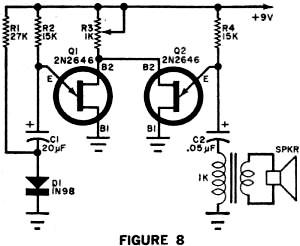 In the multivibrator, C1 charges through R2,
while diode D1 is maintained in a forward conducting state by the charging current
and the current through R1. When Q1 fires, reverse bias is applied to D1, and the
diode appears as an open circuit. Transistor Q1 remains conducting while capacitor
C1 discharges through resistor R1. At the end of this interval, D1 begins conducting
again, Q1 cuts off, and the cycle repeats. The result is a rectangular signal across
R3. In the multivibrator, C1 charges through R2,
while diode D1 is maintained in a forward conducting state by the charging current
and the current through R1. When Q1 fires, reverse bias is applied to D1, and the
diode appears as an open circuit. Transistor Q1 remains conducting while capacitor
C1 discharges through resistor R1. At the end of this interval, D1 begins conducting
again, Q1 cuts off, and the cycle repeats. The result is a rectangular signal across
R3.
Since the B2's of Q1 and Q2 are tied together, each time Q1 fires, its B2 signal
decreases the interbase voltage of Q2 and causes an increase in Q2's operating frequency.
As Q2 conducts and cuts off, the pitch of the sound heard from the loudspeaker rises
and falls sharply, giving the sound a distinct bell-like quality. The speaker is
preferably a small one, such as a 3" replacement type, to provide "tinny" reproduction.
When working with the circuit, adjust potentiometer R3 to obtain the most pleasing
sound.
Posted November 9, 2020
(updated from original post on 5/31/2013)
|





 By Frank H. Tooker
By Frank H. Tooker How the UJT works. The UJT can be represented
by a circuit approximation consisting of two resistances in series, with a diode
connected at their junction as in Fig. 1. (Also shown in the figure is the
accepted schematic symbol and base diagram for the UJT. Note that in both cases
the leads are identified as E, B1, and B2 for emitter, base-1, and base-2.) The
resistance approximation is a passive representation of the UJT. In simple terms,
this means that a pair of resistors and a diode connected as shown will not operate
as a unijunction transistor. The approximation is simply a means by which operation
of the UJT can be explained.
How the UJT works. The UJT can be represented
by a circuit approximation consisting of two resistances in series, with a diode
connected at their junction as in Fig. 1. (Also shown in the figure is the
accepted schematic symbol and base diagram for the UJT. Note that in both cases
the leads are identified as E, B1, and B2 for emitter, base-1, and base-2.) The
resistance approximation is a passive representation of the UJT. In simple terms,
this means that a pair of resistors and a diode connected as shown will not operate
as a unijunction transistor. The approximation is simply a means by which operation
of the UJT can be explained. The supply voltage, usually applied through
a series resistor, is connected across the interbase resistance, B1 to B2, with
B2 positive with respect to B1. To fire the UJT, a positive potential (called the
peak-point voltage) is applied to the emitter.
The supply voltage, usually applied through
a series resistor, is connected across the interbase resistance, B1 to B2, with
B2 positive with respect to B1. To fire the UJT, a positive potential (called the
peak-point voltage) is applied to the emitter. When the potential across Ct reaches the value
of peak-point voltage for the particular UJT being used in the circuit, the emitter
junction goes suddenly into conduction. Using the UJT approximation shown in Fig. 1,
RBl promptly drops to a much lower value and Ct in Fig. 2 discharges abruptly
through load resistor RL, producing a spike pulse of voltage across the output terminals.
When the potential across Ct reaches the value
of peak-point voltage for the particular UJT being used in the circuit, the emitter
junction goes suddenly into conduction. Using the UJT approximation shown in Fig. 1,
RBl promptly drops to a much lower value and Ct in Fig. 2 discharges abruptly
through load resistor RL, producing a spike pulse of voltage across the output terminals. The peak-point emitter current for the 2N2646
is about 5 µA; for the 2N2647 it is only 2 µA. It is important to bear in mind that
even though the 2N2647 is 2.5 times better than the 2N2646, if an electrolytic capacitor
is used in the circuit, the leakage current of the capacitor has the same effect
as an identical increase in the peak-point emitter current of the UJT. Consequently,
care must be exercised in choosing a capacitor with the lowest leakage or the value
of the 2N2647 might be lost.
The peak-point emitter current for the 2N2646
is about 5 µA; for the 2N2647 it is only 2 µA. It is important to bear in mind that
even though the 2N2647 is 2.5 times better than the 2N2646, if an electrolytic capacitor
is used in the circuit, the leakage current of the capacitor has the same effect
as an identical increase in the peak-point emitter current of the UJT. Consequently,
care must be exercised in choosing a capacitor with the lowest leakage or the value
of the 2N2647 might be lost. The circuit shown in Fig. 4 provides a
choice of either positive or negative pulses, depending on the setting of S1. Adjusting
the setting of level control potentiometer R2 adds resistance to one of the two
circuits, while it subtracts an equal amount of resistance from the other circuit.
So, when R2 is set for maximum amplitude of a negative output pulse, resistance
in the positive side of the circuit is zero, and vice versa. This gives the circuit
maximum efficiency, providing maximum pulse amplitude in either direction.
The circuit shown in Fig. 4 provides a
choice of either positive or negative pulses, depending on the setting of S1. Adjusting
the setting of level control potentiometer R2 adds resistance to one of the two
circuits, while it subtracts an equal amount of resistance from the other circuit.
So, when R2 is set for maximum amplitude of a negative output pulse, resistance
in the positive side of the circuit is zero, and vice versa. This gives the circuit
maximum efficiency, providing maximum pulse amplitude in either direction. As soon as the second UJT's emitter becomes
sufficiently positive with respect to ground, it suddenly conducts, driving the
first UJT negative and causing it to stop conducting. With the second UJT conducting
and the first cut off, Ct starts charging in the opposite direction, through the
timing resistor of the first UJT. Now, when the emitter of the first UJT becomes
sufficiently positive, it fires, and the second UJT cuts off. The alternate- stage
fire/cutoff cycle is self repeating whenever power is applied to the circuit, and
the output of the system is a train of rectangular pulses.
As soon as the second UJT's emitter becomes
sufficiently positive with respect to ground, it suddenly conducts, driving the
first UJT negative and causing it to stop conducting. With the second UJT conducting
and the first cut off, Ct starts charging in the opposite direction, through the
timing resistor of the first UJT. Now, when the emitter of the first UJT becomes
sufficiently positive, it fires, and the second UJT cuts off. The alternate- stage
fire/cutoff cycle is self repeating whenever power is applied to the circuit, and
the output of the system is a train of rectangular pulses. The tuned circuit of the generator is made up
of inductor L and capacitor C. Field effect transistor Q2 operates as a source follower
to prevent loading down the tuned circuit; this stage is not otherwise essential
to the operation of the oscillator as a sine-wave generator. The circuit shown has
operated well up to 50,000 Hz.
The tuned circuit of the generator is made up
of inductor L and capacitor C. Field effect transistor Q2 operates as a source follower
to prevent loading down the tuned circuit; this stage is not otherwise essential
to the operation of the oscillator as a sine-wave generator. The circuit shown has
operated well up to 50,000 Hz. In the multivibrator, C1 charges through R2,
while diode D1 is maintained in a forward conducting state by the charging current
and the current through R1. When Q1 fires, reverse bias is applied to D1, and the
diode appears as an open circuit. Transistor Q1 remains conducting while capacitor
C1 discharges through resistor R1. At the end of this interval, D1 begins conducting
again, Q1 cuts off, and the cycle repeats. The result is a rectangular signal across
R3.
In the multivibrator, C1 charges through R2,
while diode D1 is maintained in a forward conducting state by the charging current
and the current through R1. When Q1 fires, reverse bias is applied to D1, and the
diode appears as an open circuit. Transistor Q1 remains conducting while capacitor
C1 discharges through resistor R1. At the end of this interval, D1 begins conducting
again, Q1 cuts off, and the cycle repeats. The result is a rectangular signal across
R3.


